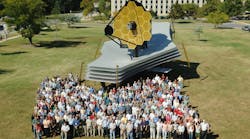The James Webb Space Telescope (JWST) was struck on one of its primary mirror segments by a meteoroid between May 23 and 25, according to NASA. The impact damaged the mirror, but “after initial assessments, the team found the telescope is still performing at a level that exceeds all mission requirements despite a marginally detectable effect in the data. Webb’s beginning-of-life performance is still well above expectations, and the observatory is fully capable of performing the science it was designed to achieve.”
Several smaller meteoroids struck the telescope earlier, but they were too small to do any damage. Meteoroids strikes will continue throughout the telescope’s time in space and were anticipated when building and testing the mirror.
While the telescope was being built, engineers used computer simulations and test impacts on mirror samples to determine how to strengthen the telescope for space. This most recent meteoroid strike, however, was larger than what was simulated and larger than the team could recreate in ground testing.
“The mirrors are made of beryllium because it is lightweight, stiff, strong and dimensionally stable (stops shrinking and expanding) at the telescope’s operating temperature,” says Paul Geithner, the deputy project manager – technical for JWST at the NASA Goddard Space Flight Center in Greenbelt, Md. “We always knew that Webb would have to weather the space environment, which includes harsh ultraviolet light and charged particles from the Sun, cosmic rays from exotic sources in the galaxy and occasional strikes by micrometeoroids within our solar system.
"So, we designed and built it with performance margin—optical, thermal, electrical, mechanical—to ensure it can perform its ambitious science mission even after many years in space.”
NASA does have plans for both avoiding future meteoroid strikes and working around really damaging strikes. For example, NASA can have the telescope adjust mirror positions to partially correct for the impacts. This lets engineers cancel out some of distortion and minimize the effect of any impact. They have already adjusted the mirrors for the recent damage, and additional adjustments will be made to fine-tune the correction.
To protect Webb in orbit in the future, NASA has several protective maneuvers up its sleeve that turn the optics away from known meteor showers before they are due to hit the telescope.
Unlike the Hubble, which was placed in orbit around the Earth, the Webb will orbit the sun at Lagrange Point 2 (L2), which is about 932,000 miles farther from the sun then the Earth.
Lagrange points were postulated by French astronomer Louis Lagrange in 1772. He calculated that for any pair of orbiting objects in space (the Sun and the Earth, for example), there are five places, or Lagrange Points, where gravitational forces from the orbiting pair and the orbiting motion of a third smaller body (the Webb telescope) balance each other. The result is that the third, less-massive object seems to hover in place relative to the other two bodies.
L2 is an ideal place for satellites like the Webb to monitor and observe outer space, especially objects outside the solar system. Satellites at L2 needn’t constantly orbit Earth, passing in and out of its shadow and, in the process, heating up and cooling down.
Unfortunately, putting the Webb at L2 means it takes a three-month Ariane 5 rocket, courtesy of the European Space Agency, to get there. So, if there is a glitch in Webb’s hardware or meteoroid damage to parts of it, astronauts will not be able to hitch a ride on the Shuttle (even if it were still active) to get there, repair it and get back.
NASA says it still expects to unveil the first science-quality images from the telescope on July 12 despite the meteoroid strike.

